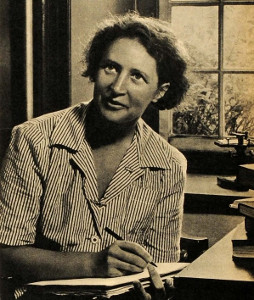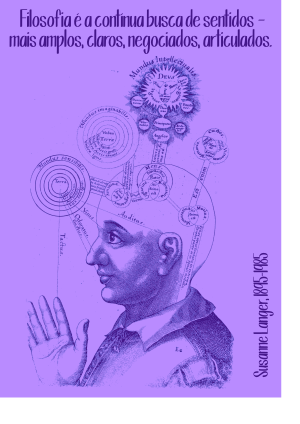Susanne Langer facts for kids
Quick facts for kids
Susanne Langer
|
|
|---|---|

Langer in 1945
|
|
| Born |
Susanne Katerina Knauth
December 20, 1895 New York City, U.S.
|
| Died | July 17, 1985 (aged 89) Old Lyme, Connecticut, U.S.
|
| Education | Radcliffe College (BA, 1920; PhD, 1926) |
| Spouse(s) |
William Leonard Langer
(m. 1921; div. 1942) |
| Era | 20th-century philosophy |
| Region | Western philosophy |
| School | Process philosophy |
| Doctoral advisor | Alfred North Whitehead |
|
Main interests
|
Philosophy of mind, aesthetics |
|
Notable ideas
|
Distinction between discursive and presentational symbols |
|
Influences
|
|
|
Influenced
|
|
Susanne Katherina Langer (/ˈlæŋər/; née Knauth; December 20, 1895 – July 17, 1985) was an American thinker, writer, and teacher. She is famous for her ideas about how art affects our minds. She was one of the first American women to have a successful career in philosophy. Many people remember her for her 1942 book, Philosophy in a New Key. She also wrote a follow-up book called Feeling and Form: A Theory of Art in 1953. In 1960, she became a member of the American Academy of Arts and Sciences.
Contents
Her Life Story
Susanne Katherina Knauth was born in Manhattan's West Side in New York City. Her parents, Antonio Knauth and Else Uhlich, came from Germany. Even though she was born in America, German was her first language at home. She spoke German throughout her life and kept her German accent.
Susanne grew up surrounded by art and creativity, especially music. She learned to play the cello and the piano. She continued playing the cello for the rest of her life. As a girl, she loved reading and reciting poems and stories. This made her love writing, and she often wrote her own stories for her younger siblings. She also loved nature, which grew from summers spent at her family's cottage on Lake George.
In 1921, she married William Leonard Langer, who was also a student at Harvard. They moved to Vienna, Austria, to continue their studies. They had two sons. Later, they moved back to Cambridge, Massachusetts, and divorced in 1942. Susanne Langer passed away on July 17, 1985.
Her Education and Teaching
Susanne Langer went to a private school called Veltin School for Girls. She also had tutors at home. In 1916, she started studying at Radcliffe College. She earned her first degree in 1920. She then continued her studies in philosophy at Harvard. There, she received her master's degree in 1924 and her doctorate in 1926.
After her studies, she taught philosophy at Radcliffe from 1927 to 1942. She also taught at the University of Delaware and Columbia University. From 1954 to 1962, she taught at Connecticut College. She also taught at other universities like the University of Michigan and New York University.
Her Philosophy
Susanne Langer explored how our minds connect with art and how we make sense of the world. Her ideas were new and sometimes different from what other thinkers believed. This led her to deeply study how human consciousness works.
Langer believed that the human mind is always creating meaning. We do this by "seeing" one thing in terms of another. Her first big book, Philosophy in a New Key, shared an important idea: humans have a basic need to use symbols. We invent meanings and give meaning to everything around us.
Langer thought that the human mind is always changing experiences into symbols. She called the mind "a fountain of more or less spontaneous ideas."
Symbols: Discursive and Presentational
One of Langer's most famous ideas is the difference between discursive and presentational symbols.
- Discursive symbols are like words in a sentence. They have clear, fixed meanings that combine to make a new meaning. You understand them step-by-step.
- Presentational symbols are different. Think of a painting or a piece of music. The parts don't have fixed meanings on their own. You have to understand the whole thing to get its meaning. For example, a color in one painting might mean something totally different in another. A musical note only makes sense within the whole song.
Langer believed that understanding symbols is the most important part of philosophy. Like another philosopher, Ernst Cassirer, she thought that using symbols is what makes humans different from animals. Animals react to signs, but humans use symbols to create complex ideas and language. Our feelings are shaped by these symbols and language.
Art and the Virtual World
Langer was one of the first philosophers to talk about the idea of the "virtual." She connected art to this concept. For her, when an artist creates a work of art, they are building a kind of virtual world. She described the virtual as "the quality of all things that are created to be perceived."
She saw the virtual not just as something in our minds, but as something real and physical. A painting or a building, for example, creates a special space for us to think and feel. She believed that an architect doesn't just build a space to live in, but translates it into a "virtual entity" for us to experience.
In her later years, Langer wanted to create a scientific and psychological theory of the "life of the mind." Her final work, Mind: An Essay on Human Feeling, explored how art and human feelings are connected.
The Biology of Feeling
Langer's interest in the mind and art came from her idea that art shows human feelings and expressions. She developed a biological theory of feeling. She believed that "feeling" is a biological concept linked to how we evolved.
In her essay "Mind," Langer connected early human evolution to how we understand the mind today. She explained that living things developed through natural selection. Certain behaviors and body functions were shaped to help them survive. Langer said that our body's organs work with specific rhythms. These rhythms must work together to keep us alive. She believed this development was the start of our central nervous system, which is key to how humans think and interact.
Rhetoric and Communication
Susanne Langer's work on symbols and meaning is also important in the study of rhetoric (the art of speaking or writing effectively). She suggested that symbols are how communities gain and build knowledge. She thought that language doesn't just share information. Instead, it creates symbols that help humans build their own reality. She said, "language is intrinsic to thinking, imagining, even our ways of perceiving."
According to some scholars, Langer's ideas suggest that meaning comes from the relationship between a community, its discussions, and each person. Her work might be seen as different from older ideas, like those of Aristotle. She argued that discussions form through shared sensory experiences between people, not just through logic. Langer's ideas about symbols and language, and how they affect people and communities, are still studied in modern rhetoric.
Her Influences
Langer's work was greatly shaped by two other philosophers: Ernst Cassirer and Alfred North Whitehead. Whitehead, a mathematician and philosophy professor from England, was Langer's teacher at Radcliffe. He taught her about the history of human thought and modern philosophy. He helped her develop her own ideas, which she wrote about in her first book, The Practice of Philosophy. Whitehead continued to inspire her throughout her career. She believed, like him, that new ways of thinking could lead to a rebirth of philosophical creativity. Langer dedicated Philosophy in a New Key to "Alfred North Whitehead, my great Teacher and Friend."
Her other main influence was the German philosopher Ernst Cassirer. Cassirer studied theories of symbolism. Cassirer's ideas strongly influenced Langer's book Philosophy in a New Key. She believed that creating symbols is the main activity in art, myths, rituals, science, math, and philosophy. She said, "Every major advance in thinking... springs from a new type of symbolic transformation." She agreed with Cassirer that understanding art must go hand-in-hand with understanding the mind.
Her Legacy
Susanne Langer influenced many different fields. For example, her work was used by psychologist Abraham Maslow in his book Motivation and Personality. Urban planner Kevin A. Lynch cited her in The Image of the City. Inventor William J. J. Gordon used her ideas in Synectics. Anthropologist Clifford Geertz mentioned her in The Interpretation of Cultures. Art scholar Ellen Dissanayake and digital media theorist Janet Murray also found her work important. Her ideas are still studied in many college courses on art and philosophy.
Selected Publications
Books
- The Cruise of the Little Dipper, and Other Fairy Tales (1924 illustrated by Helen Sewall)
- The Practice of Philosophy (1930, foreword by Alfred North Whitehead)
- An Introduction to Symbolic Logic (1937), ISBN: 978-0-486-60164-9
- Philosophy in a New Key: A Study in the Symbolism of Reason, Rite, and Art (1942), ISBN: 978-0-674-66503-3
- Language and Myth (1946), translator, from Sprache und Mythos (1925) by Ernst Cassirer, ISBN: 978-0-486-20051-4
- Feeling and Form: A Theory of Art (1953)
- Problems of Art: Ten Philosophical Lectures, 1957
- Reflections on Art (1961) (editor)
- Philosophical Sketches (1962), ISBN: 978-1-4351-0763-2
- Mind: An Essay on Human Feeling, three volumes (1967, 1972, and 1982)
See also
 In Spanish: Susanne Langer para niños
In Spanish: Susanne Langer para niños
- Symbolic behavior



